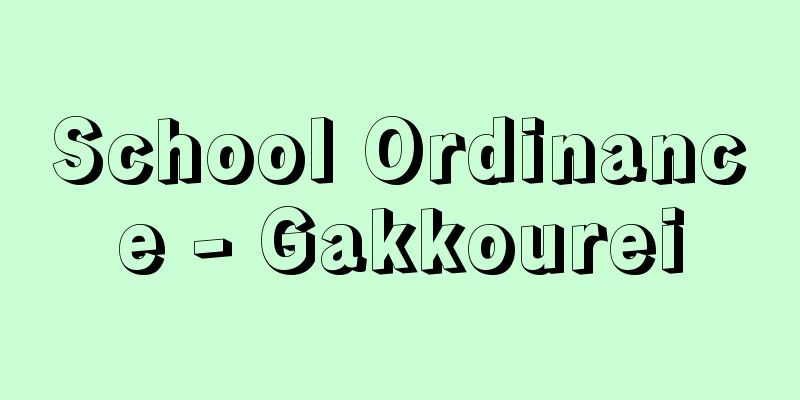School Ordinance - Gakkourei

|
It is a general term for the Imperial University Act, promulgated in March 1886 (Meiji 19), and the Elementary School Act, Middle School Act, and Normal School Act, all of which were promulgated in April of the same year. In a broader sense, it can also include the Elementary School Act of the 1880s, the High School Act, and the various School Acts of the 1890s (Vocational School Act, Girls' High School Act, Private School Act, and Technical School Act). The Imperial University Act, as it states, "The purpose of the Imperial University is to teach academic arts and sciences in accordance with the needs of the nation and to explore their depths," suggested the framework of a nationalistic education system and the functions of education and research, and established five specialized universities, including a law school, and a graduate school. Until the Imperial University was established in Kyoto in 1897 (Meiji 30), the only Imperial University was located in Tokyo (the former University of Tokyo). The Elementary School Act established a two-stage system of four-year elementary school and two-year high school, with four years of elementary school being compulsory. In addition, three-year elementary schools could be established depending on the local conditions. The Middle School Act had a dual structure of vocational and academic advancement, and accordingly established a five-year ordinary middle school and a two-year high school. The former was to be one school in each prefecture, the latter a preparatory step to the Imperial University and an institution for training leaders for the upper classes, and five schools were established in five districts across the country. The Normal School Act saw the ideal teacher as one with the temperament of obedience, faith, and dignity, and established one higher normal school in Tokyo and one ordinary normal school in each prefecture. The former was to train ordinary normal school principals and teachers, and the latter was to train public elementary school principals and teachers. In this way, the School Act aimed to establish a school system from the center → prefectures → cities, towns, and villages as national education based on the principle of national wealth and strength, in preparation for the development of a modern national system. Although various revisions were made thereafter, the school system formed the basis of the National School Act of the Showa era. [Hiroki Otsuki] "Fifty Years of the Education System" (1922), compiled and published by the Ministry of Education; "Research on the History of Educational Administration in the Early Meiji Period" by Akimoto Kaneko (1967, Kazama Shobo) ; "Education in the Meiji Period" by Shin Naka (1967, Shibundo, Japanese History Paperbacks) The current location of the University of Tokyo. Hon-Fuji-cho, Hongo-ku (currently Hongo, Bunkyo-ku, Tokyo). "Famous Places in Japan" (1900, Meiji 33) National Diet Library Tokyo Imperial University The school building was located in Yushima, Hongo Ward (present-day Yushima, Bunkyo Ward, Tokyo). "Geographical Photo Album, Inland Section, Volume 2" (1900, Meiji 33) National Diet Library Higher Normal School Source: Shogakukan Encyclopedia Nipponica About Encyclopedia Nipponica Information | Legend |
|
1886年(明治19)3月公布の帝国大学令、同年4月公布の小学校令、中学校令、師範学校令の総称であるが、広義には、明治20年代の小学校令、高等学校令、30年代の諸学校令(実業学校令、高等女学校令、私立学校令、専門学校令)を含む場合もある。 帝国大学令は、「国家ノ須要(すよう)ニ応スル学術技芸ヲ教授シ及其(その)蘊奥(うんおう)ヲ攻究スルヲ以(もっ)テ目的トス」とあるように、国家主義教育体制の枠組みと、教育、研究の機能を示唆し、法科大学などの五つの分科大学と、大学院を設置した。1897年(明治30)京都に帝国大学が設立されるまで、唯一の帝国大学は東京にあった(旧東京大学)。小学校令は、尋常小学校、高等小学校の2段階、四・四の8年制とし、尋常小学校4年間は義務化された。また土地の情況に応じて3年制の小学簡易科を置くことができた。中学校令は、実業方面と進学方面の二重構造からなっており、それに対応して、5年制の尋常中学校と2年制の高等中学校を設けた。前者は各府県に各1校、後者は帝国大学への予備階梯(かいてい)および社会上流の指導者養成機関とし、全国を5区に分け5校が設置された。師範学校令は、順良、信愛、威重の気質を教師像の典型と見立て、東京に高等師範学校1校を置き、尋常師範学校は府県ごとに各1校とした。前者は尋常師範学校長および教員、後者は公立小学校長および教員を養成するものとした。このように学校令は、近代国家体制の整備に向けて、中央→府県→市町村の学校体系を、国家富強主義に基づく国体教育として確立しようとするものであった。学校制度としては、以後、種々の改正がなされながらも、昭和の国民学校令に至るまでの根幹をなした。 [大槻宏樹] 『文部省編・刊『学制五十年史』(1922)』▽『金子昭基著『明治前期教育行政史研究』(1967・風間書房)』▽『仲新著『明治の教育』(1967・至文堂・日本歴史新書)』 現在の東京大学所在地。本郷区本富士町(現在の東京都文京区本郷)。『日本之名勝』(1900年〈明治33〉)国立国会図書館所蔵"> 東京帝国大学 本郷区湯島(現在の東京都文京区湯島)にあった校舎。『地理写真帖 内国之部 第2帙』(1900年〈明治33〉)国立国会図書館所蔵"> 高等師範学校 出典 小学館 日本大百科全書(ニッポニカ)日本大百科全書(ニッポニカ)について 情報 | 凡例 |
Recommend
Menderes River (English spelling)
A river in southwestern Turkey, flowing west from ...
Kux
…This was the Löhenshaft (contract system), a rel...
Glagolitic alphabet - Glagolitic letters
One of the two scripts used along with Cyrillic to...
Death Instinct - Todestriebe [Germany]
S. Freud's term. More precisely, the "dea...
Rules and Regulations
A form or designation of law that was widely used...
François de La Rocque
1885‐1946 A count and leader of right-wing groups ...
Marks, H.
…In Japan, the Electricity Memorial Day on March ...
Lice (虱∥蝨) - sucking louse
A general term for parasitic insects belonging to ...
"General Finnish Phonetic History" - Ippan Finland Onsei
…His phonetic, morphological and syntactic theory...
Red Unclean
It refers to the taboo of female blood. In the pa...
Monogenetic volcano
… [Monogenetic and polygenetic volcanoes] The typ...
Luminol test - Luminol test
It is a method of preliminary testing to select b...
Oligotrophic lake
…Originally a term in limnology, it refers to the...
Lomazzo, Giovanni Paolo
Born: April 26, 1538, Milan Died: February 13, 160...
Asperigillus terreus (English spelling)
…It is obtained by treating itaconic anhydride, w...









